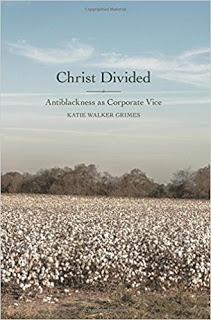
It's not often I feel like cheering when I read a smart, dense theological work like Katie Grimes' Christ Divided: Antiblackness as Corporate Vice (Minneapolis: Fortress, 2017). I did so repeatedly as I read this book. I like how
1. Katie turns so many taken-for-granted theological and cultural presuppositions upside down, as she tells us that it's not about white supremacy, but about antiblackness supremacy; that the questions we need to be asking are not about the lack of virtue of black people living in the afterlife of slavery, but about the way antiblackness vice inhabits the bodies of white people; that we need, with feminist theologians in general, to stop abstracting and start talking about the body, about real embodied human beings and the effect of abstract ideas on their real embodied selves and lives.
2. She brilliantly demonstrates that the body of Christ is, as was Jesus' body, porous, and, "More than just a cause of his death, Jesus' feminized porosity made his ministry possible" (p. 219). This theological perspective allows her to turn the traditional notion of the cultic eucharist — the eucharistic gatherings of the body of Christ in which the body of Christ is offered as food to the faithful as all about feeding souls — on its head, as she insists that what's of central importance to the eucharist is that it's a meal. It's a meal for bodies that are living embodied lives in an embodied world to which the boundaries of the body of Christ are porous…. So that sacraments like baptism and eucharist do not magically remove the porosity of the body of Christ and the antiblackness supremacy that white worshipers import into the church from the world itself, by carrying this vice in their bodies — so that the church and its sacraments are not the magical, mystical solution to negate the sinful effects of the secular world, as sacramental optimists want us to think, but:
The church exists most fundamentally not as a city or society, but as a body. As such, it will always be susceptible to the habituating power of the world it inhabits (p. 219).
And there's also this:
Christianity bears at least as much responsibility for Africanizing slavery and sustaining its afterlife as any secular power…. Antiblackness supremacy does not simply operate through social structures; it inhabits white bodies as a vice. As long as white and other nonblack people continue to cling to these habits, they will attempt to twist any social, political, or ecclesial order into the shape of slavery's afterlife (p. 211).
With these citations, I'm pointing to the final section of the book, which deals with the ecclesial consquences of corporate vice and with questions of sacramental theology. This part of the book is, quite simply, wonderful, and I hope that Katie will write more about these matters. Here's one of the passages in this final section of the book that made me stand up and cheer, which I particularly hope to see her develop further in future books and articles:
Due to the way it treated Jesus like a slave in general and subjected him to sexual violence in particular, crucifixion therefore also emasculated Jesus. Just as slavery rendered male slaves symbolically feminine by making them uniquely vulnerable to sexual abuse, so the sexually violent character of crucifixion placed Jesus's naked body in a feminine position. Rather than penetrating women and male subordinates as true men ought, Jesus was the penetrated one. In this way, the condemned typically were crucified naked to heighten the humiliating contradiction between the spectacle of their unpenetrating penises and their violently penetrated bodies (p. 217).
We can hardly talk credibly or coherently about the body of Christ — the church, its eucharistic meal — without talking about these issues, can we? That is to say, we can't continue doing so unless we want to continue pretending that the mythical body of Christ is somehow the mystical body of Christ (p. xvii, citing Arthur Falls)….
This is powerful theological reflection. It gives me a bit of hope, as an aging, long-since-discarded gay Catholic theologian in a long-term partnered relationship, who has been denied a role in "official" Catholic theological conversations and has therefore found much Catholic theology produced in the last several decades totally alienating, that some younger theologians may begin breaking the stultifying mold that has proven so toxic to others of us who have walked ahead of them.
(My apologies to all of you readers for my silence last week. Our internet broke on Tuesday, and the provider fixed the problem only on Saturday. We could continue using our cell phones to connect to the internet, but were receiving daily notices of extortionate charges for doing so, since we were not going through our home wifi.
That's a large part of why I've been silent. The other is, if I'm honest, that I feel lately as I'm swimming in a huge sea of malicious, intractable stupidity, and my arms and legs are growing tired of the swim. It's just all around us in American culture and a large swathe of global culture these days, and it's hard to cope with — especially as one's barriers grow thinner due to age and years of struggling against social and ecclesial marginalization. I encountered so many nasty, bullying types online in the past several weeks — typically straight men intent on trying to communicate to me the space men like me ought to occupy — that I was almost happy to be without easy access to the internet for a good bit of last week.)
The photo of the cover of Christ Divided is from its Amazon page.

